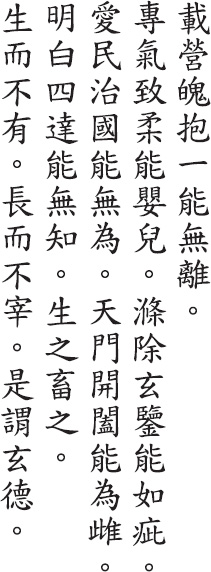10
 |
Can you keep your crescent soul from wandering can you make your breath as soft as a baby’s can you wipe your dark mirror free of dust can you serve and govern without effort can you be the female at Heaven’s Gate can you light the world without knowledge can you give birth and nurture but give birth without possessing raise without controlling this is Dark Virtue |
The Chinese say that the hun, or bright, ethereal, yang soul, governs the upper body and the p’o, or dark, earthly, yin soul, concerns itself with the lower body. Here, Lao-tzu mentions only the darker soul. But the word p’o also refers to the dark of the moon, and the opening phrase can also be read as referring to the first day of the new moon. Either way, dark of the soul or dark of the moon, Taoist commentators say the first line refers to the protection of our vital essence, of which semen and vaginal fluid, sweat and saliva are the most common examples, and the depletion of which injures the health and leads to early death.
HSUAN-TSUNG says, “The first transformation of life is called p’o. When the p’o becomes active and bright, it’s called hun.”
WANG P’ANG says, “Life requires three things: vital essence, breath, and spirit.”
CHIAO HUNG says, “The mind knows right and wrong. Breath makes no distinction. If we concentrate our breath and don’t let the mind interfere with it, it remains soft and pure. Who else but a child can do this?”
CHUANG-TZU says, “The sage’s mind is so still, it can mirror Heaven and Earth and reflect the ten thousand things” (Chuangtzu: 13.1).
WU CH’ENG says, “Our spirit dwells in our eyes. When the eyes see something, the spirit chases it. When we close our eyes and look within, everything is dark. But within the dark, we still see something. There is still dust. Only by putting an end to delusions can we get rid of the dust.”
WANG AN-SHIH says, “The best way to serve is by not serving. The best way to govern is by not governing. Hence, Lao-tzu says, ‘without effort.’ Those who act without effort make use of the efforts of others. As for Heaven’s Gate, this is the gate through which all creatures enter and leave. When it is open, it is active. When it is closed, it is still. Activity and stillness represent the male and the female. Just as stillness overcomes activity, the female overcomes the male.” (The images of young women were often carved on either side of the entrance to ancient, subterranean tombs.)
SU CH’E says, “What lights up the world is the mind. There is nothing the mind does not know. And yet no one can know the mind. The mind is one. If someone knew it, there would be two. Going from one to two is the origin of all delusion.”
LAO-TZU says, “The Way begets them / Virtue keeps them” (Taoteching: 51).
WANG PI says, “If we don’t obstruct their source, things come into existence on their own. If we don’t suppress their nature, things mature by themselves. Virtue is present, but its owner is unknown. It comes from the mysterious depths. Hence, we call it ‘dark.’”
The first line has had numerous interpretations, to which I have added yet another. Most commentators agree that the character tsai should be placed at the beginning of this verse, instead of at the end of the previous verse, where it would function as equivalent to a punctuation mark indicating a rhetorical question. Tsai normally means “carry,” but it can also mean “newly,” as in the phrase tsai-sheng-p’o, “newly born dark moon/soul,” or as Lao-tzu uses it here, tsai-ying-p’o, “newly lit dark moon/soul.” In lines four and six, a number of editions invert “effort” and “knowledge.” I have followed the edition of Ho-shang Kung and the arguments of Lo Chen-yu and Kao Heng in preferring the arrangement here. After line eight, most editions add wei-er-pu-shih, “develop without depending,” which also appears in a similar sequence in verses 2 and 51 in some editions. I have followed the Mawangtui texts in omitting this line. This verse, which expresses Lao-tzu’s yogic regimen more than any other in the Taoteching, is absent from the Kuotien texts.